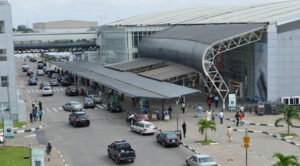Professional Critique Report:
Murtala Mohammed International Airport (MMIA) Rehabilitation Project
Overview.
Hon. Minister Festus Keyamo’s recent statement following FEC’s approval of the MMIA overhaul outlines a transformative project: full redevelopment of Terminal One, expansion of Terminal Two, apron upgrades, new roadways, and smart technologies—financed internally through the Renewed Hope Infrastructure Development Fund. It is a significant shift from the debt-driven model, especially one reliant on Chinese loans.
While this vision is commendable and the need for an upgrade indisputable, several operational, economic, and strategic risks must be addressed to ensure long-term national benefit.

Project Justification: Sound and Overdue
Terminal One, built in 1979, has reached structural and functional obsolescence. The overhaul is essential for aligning Nigeria’s main international gateway with global aviation standards (ICAO, IATA).
Minister Keyamo’s approach to reconfigure and rebuild Terminal One—rather than patch it further—is correct. Current traffic, infrastructure decay, and global connectivity demands make this project not just valid but urgent.

Local Funding—A Welcome Shift
The decision to fund this project through domestic subsidy savings—rather than Chinese debt—is bold and healthy. It marks a departure from the previous administration’s heavy reliance on tied loans (e.g., the Chinese-funded Terminal Two).
However, transparency in fund allocation is vital. The Renewed Hope Fund must operate with public accountability, including quarterly audit publications.

Security Works Awarded to Construction Contractor—Strategic Error
Including the perimeter security fence and intrusion detection systems in the same contract as civil construction is a major misstep:
Security is a specialist function, requiring surveillance integration, emergency response frameworks, and aviation-grade access control, beyond the purview of a construction firm like CCECC.
Integrating perimeter security into a general construction contract dilutes performance accountability and operational depth.
Best practice: Separate perimeter security into a standalone, competitively bid contract, led by certified third-party aviation security firms like Eden & McWhit, who align with ICAO Annex 17 and TSA Part 1542 protocols.
The CCECC Subcontractor Monopoly—A Risk to Local Content and Standards
Chinese firms, particularly CCECC, have a consistent record of:
- Preferring Chinese subcontractors and equipment.
- Importing labor rather than building local capacity.
- Restricting competitive product sourcing to China.
In projects like Angola’s Luanda Airport and Ethiopia’s Bole Expansion, local content averaged less than 15%. Nigeria must avoid repeating that mistake.
The MMIA project should mandate at least 40% local content, involving Nigerian civil engineers, security system integrators, facility managers, and ICT providers.

Maintenance Contracts Should Not Be Bundled
Post-construction maintenance should not default to the builder. This entrenches dependency, siphons money offshore, and blocks Nigerian firms from long-term value creation.
Recommendation: Publicly tender separate maintenance contracts, preferably favoring Nigerian-led consortia trained on new systems during construction.
Risk Management—Avoid Putting All Eggs in One Basket
Assigning virtually all design, construction, security, and integration works to one Chinese firm (CCECC) is unwise:
- It centralizes systemic risk.
- Limits quality assurance through independent oversight.
- Blocks innovation from alternative vendors (EU, U.S., Israel).
This violates basic procurement diversification principles and should be reconsidered. Each project segment—design, execution, security, IT—should have distinct, competitive bidders.

Neglect of Nigerian Entrepreneurs—A National Loss
This is a missed opportunity to involve and scale up Nigerian aviation entrepreneurs. Firms like Eden & McWhit offer security, training, and operational support aligned with global standards. Denying them a role slows industry growth.
The FG must institutionalize a local vendor onboarding framework across all procurement layers—security, systems, maintenance, tech, and logistics.
Broader Aviation Strategy—Don’t Just Build, Plan for Use
Keyamo correctly acknowledges that brand-new terminals in Abuja, Kano, and Port Harcourt are underutilized (below 30% capacity). This underscores a systemic problem: a supply without demand strategy.
The FG must simultaneously drive aviation policy reforms—regional air route incentives, cargo logistics hubs, and airline partnerships—to ensure infrastructure isn’t wasted.

Conclusion
Minister Keyamo’s redevelopment blueprint is necessary, well-conceived, and marks a financial departure from debt-reliant models. However, its implementation risks undermining local capacity, misallocating operational functions, and centralizing too much power in a single foreign contractor.
Recommendations at a Glance:
Issue Recommendation
- Bundled Security Contracts: Unbundle and rebid to aviation security specialists.
- Local Content: Mandate minimum 40% Nigerian subcontractor participation.
- Maintenance Rights: Exclude CCECC from automatic maintenance; tender it separately.
- Single Contractor Monopoly: Diversify contractors by specialty and procurement.
- SME Inclusion: Incubate Nigerian tech, logistics, and service SMEs on a project.
- Long-Term Use Planning: Link infrastructure with broader aviation development strategy.
> “An airport is not just a building—it’s a symbol of sovereignty, a gateway to the world, and a cornerstone of economic growth. Let’s make MMIA not just a monument, but a national ecosystem.”
Dr. G. Fraser. MFR
Fraser Consulting Consortium.




